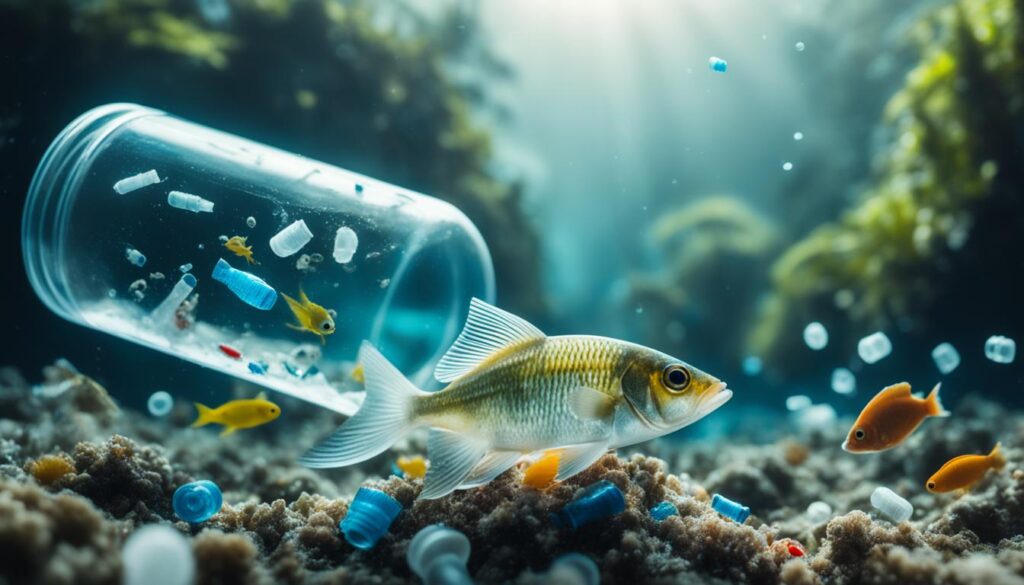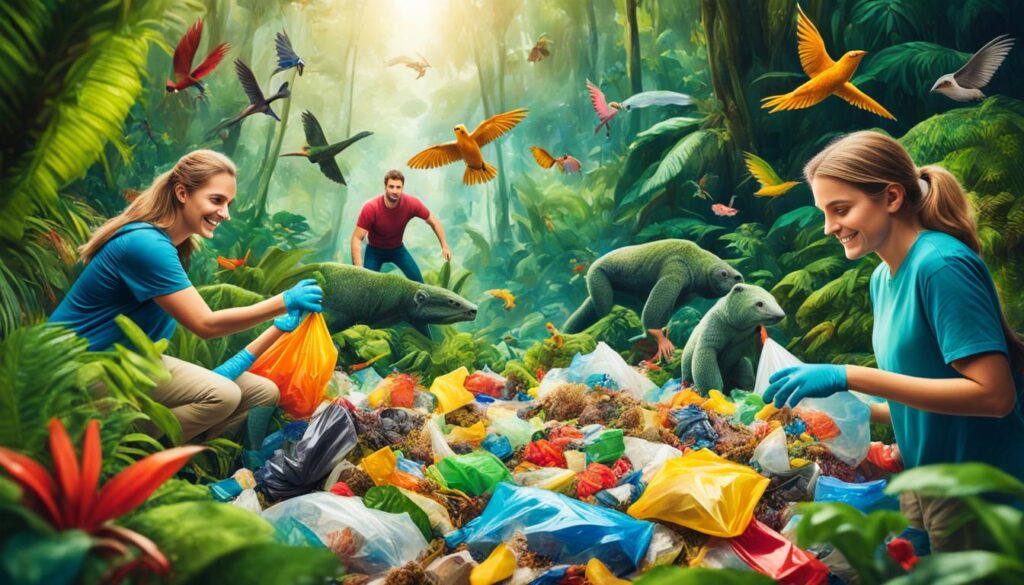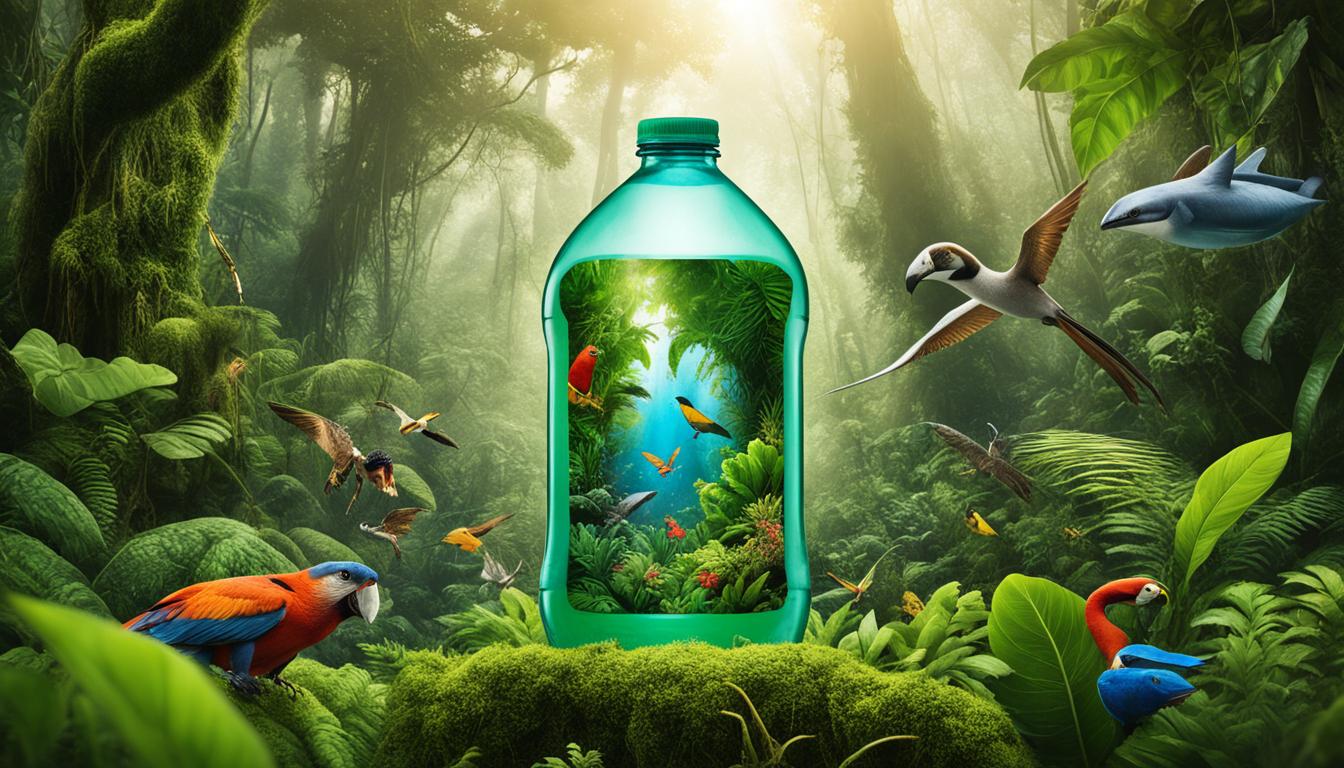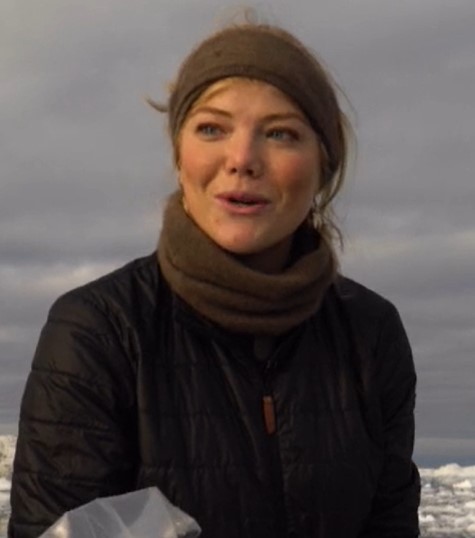Our world loves plastics for their convenience, but we ignore the harm they cause to our rainforests1. Plastic takes about 1000 years to break down, leaving a lasting impact on these vital ecosystems1. It harms forests and wildlife for generations1. Plastic pollution in rainforests goes beyond just trash. Microplastics1 and chemicals1 damage the core of these habitats, breaking food chains and threatening many species.
Plastic waste is a big problem in places like the Amazon and Congo, changing the balance of these unique natural areas2. The author’s stories of plastic in the Amazon show how bad the problem is2. With more people on Earth, protecting these areas is more important than ever.
Key Takeaways
- Plastic pollution is a big threat to rainforests, harming them in many ways.
- Plastic waste is everywhere in rainforests, like in the Amazon, showing how bad the problem is.
- Plastic does more than just pollute; it breaks food chains and threatens many species.
- We must protect rainforests from plastic pollution as our population grows.
- Recycling and using less plastic are key to saving rainforests and their life.
Plastic Pollution: A Silent Threat to Our Forests
Plastic pollution has sneaked into our rainforests, harming their delicate balance. Tiny plastic pieces, less than 5 millimeters, have mixed into the soil3.
These small plastics can get into the soil from sewage sludge or when big plastics break down4. Once there, they can harm earthworms, which are key to soil health and plant growth3.
But the danger isn’t just from the plastic itself. These small pieces can carry harmful germs and viruses, making life harder for rainforests4. This messes up the ecosystem, putting the rainforest’s health at risk.
“Plastic makes up 80% of all marine debris found from surface waters to deep-sea sediments3. It is estimated that over 100,000 marine animals die annually due to plastic waste3. By 2050, it is projected that every sea bird on Earth will have swallowed plastic3.”
Microplastics Infiltrating Soil and Ecosystems
Microplastics are a big problem for rainforests. They get stuck in the soil, upsetting the ecosystem balance. This threatens the health and survival of the rainforest4.
| Plastic Pollution Statistic | Data |
|---|---|
| Plastic waste dumped into oceans, rivers, and lakes per day | 2,000 garbage trucks full3 |
| Plastic waste leaking into aquatic ecosystems annually | 19-23 million tonnes3 |
| Annual plastic production globally | Over 400 million tons3 |
| Plastic ending up in the ocean annually | At least 14 million tons3 |
Microplastics in soil harm rainforest ecosystems. They affect earthworms, which are vital for soil health and plant growth4.
We need to understand plastic pollution in rainforests to find solutions4. Fighting plastic pollution in our forests is a team effort. If we don’t, it could have huge effects on our planet345.
The Devastating Effects of Plastic on Wildlife
Plastic pollution is a big threat to wildlife in rainforests6. Animals, being curious and hungry, might think plastic is food. This can lead to plastic ingestion, causing blockages and even death7. Animals can also get trapped in plastic, leading to serious health issues like overheating and dehydration6.
Plastic waste often ends up in wild areas, making it easier for animals to encounter it6. This is a big problem because plastic is harmful to wildlife7.
Over 250 marine animals have been hurt by plastic debris8. Whales and seals eat plastic thinking it’s food, which damages their stomachs8. Microplastics are also a big problem, harming many species, from seabirds to humans.
Plastic pollution is everywhere, with microplastics found in many living things8. These tiny plastics can make marine life eat less and have fewer babies, hurting their health and the environment8. We find microplastics in our drinking water, bottled water, and even in seafood, which is worrying for both animals and humans.
“Plasticosis” disease has been found in seabirds because of microplastics, causing ongoing inflammation and damage8.
Our plastic problem is huge, with humans making a lot of new plastic each year7. Only a small part of plastic gets recycled, and the rest often ends up in landfills, taking hundreds of years to break down7. We need to act fast to save our wildlife and ecosystems.
Plastic and Rainforest: A Deadly Combination
Plastic pollution and rainforests don’t mix well. Plastic waste harms the balance in these vital places. It hurts the many species that live there, causing damage to their homes and reducing the variety of life.
Disrupting Delicate Ecosystems
Plastic, including tiny pieces, can make soil worse and pollute water. This affects plants and animals, making it hard for them to survive9. It can also bring in new species that harm the native ones, weakening the rainforest10.
Plastic pollution hurts rainforests in many ways10. It can stop plants from making food and affect the food chain. Animals getting tangled in or eating plastic can also face big problems9.
“Plastic pollution is a silent threat to the delicate balance of rainforest ecosystems, leading to habitat destruction and the loss of irreplaceable biodiversity.”
Rainforests are key in fighting climate change10. But plastic waste can harm their ability to do this. This makes the problem of climate change even harder to solve10.
We need to act fast to stop plastic from harming rainforests. We must find ways to reduce plastic waste and protect these important places.
Microplastics in the Food Chain: A Ticking Time Bomb
Microplastics in rainforests threaten the food chain. These tiny plastics get eaten by small organisms, then move up the food chain. This process, called bioaccumulation, makes harmful chemicals in the plastics more dangerous11.
This leads to biomagnification, where toxins increase in larger predators11. This is a big problem for the health of rainforest ecosystems.
Bioaccumulation and Biomagnification
These contaminants can mess with the hormones of wildlife. This causes big problems for the entire food web11. The danger from microplastics is huge, threatening the balance of the rainforest.

Studies show how big the problem is12. Indonesia makes over 7.8 million metric tons of plastic waste each year, second only to China12. They dump about 100 garbage trucks of plastic into the sea every day12.
This waste harms the ocean and gets into the rainforests too. We need to act fast to stop this. If we don’t, the damage to the rainforest could be huge1112.
We must work together to reduce plastic waste. This is the only way to protect our rainforests and the animals that live there.
Plastic Entrapment: A Lethal Danger for Animals
Plastic waste is a big threat to animals living in rainforests. Animals can get trapped in plastic bags and containers, leading to serious harm13. This problem is huge, with 100,000 marine animals dying from plastic each year13.
Being trapped can cause animals to overheat, suffocate, or starve. They also become easy prey for other animals. Most of this plastic ends up in wild areas, making it hard for animals to avoid it13. Every year, 1 million sea birds die from plastic13.
There’s also a lot of “ghost fishing equipment” in the oceans, harming marine life13. The oceans are filled with 51 trillion pieces of plastic13. Sadly, 56% of whales, dolphins, and porpoises have eaten plastic13.
We need to act fast to protect animals and their homes. Reducing plastic use, better waste management, and conservation efforts are key. This way, animals can live without the danger of plastic pollution.
We must focus on solving plastic entrapment to help animals in rainforests. By using less plastic, managing waste better, and protecting nature, we can make a safer world for wildlife.
The Long-Lasting Legacy of Plastic Pollution
Plastic is very durable, taking about 1,000 years to break down14. This means plastic pollution in rainforests can affect future generations. As plastic gets smaller, it becomes microplastics and nanoplastics. These tiny pieces spread through the environment, polluting soil, water, and food14.
Plastic waste in rainforests can harm these ecosystems for a long time14. Microplastics hurt the growth of important plants like phytoplankton. This can lead to a 161-168% decrease in their numbers and health15. This affects the entire food chain in the rainforest.
Breaking Down the Breakdown Process
Plastic doesn’t biodegrade like other materials; it just gets smaller and stays in the environment14. So, the plastic pollution in rainforests will keep building up. It will affect these ecosystems for many centuries.
We’re still learning about the long-term effects of plastic pollution in rainforests. But, it’s clear that it’s a big threat to these important habitats14. Knowing how long plastic waste lasts helps us see why we need to act fast to protect our rainforests.
“Plastic is a highly durable material, taking approximately 1,000 years to decompose fully. This long-lasting nature of plastic pollution means that the impact on rainforest ecosystems can persist for generations.”
Protecting Our Rainforests from Plastic Invasion
The crisis of plastic pollution is a big threat to our rainforests16. These forests, which cover about 13 percent of the Earth, are being cut down at a rate of 80,000 acres a day16. This loss harms many species and reduces the planet’s ability to absorb carbon dioxide16.
To protect our rainforests, we need to act on many fronts17. We should use less plastic, recycle better, and stop plastic from getting into rainforests17. Doing these things can help rainforests stay safe from plastic and keep being the important resources they are.
Helping rainforests means giving money to protect them16. Paying countries to keep their rainforests healthy is one way to do this16. Programs like REDD+ pay countries to reduce deforestation, which helps protect these vital areas16.
Adding the cost of carbon emissions to farming could also help fund conservation16. This way, we can encourage actions that protect the environment. It helps local communities and governments protect our rainforests from plastic pollution.
The Amazon’s Indigenous People are key in fighting climate change18. Their efforts to protect the rainforests are vital. We must support them to keep these natural wonders safe for the future18.
Working together, we can fight the plastic invasion and protect our planet’s vital resources161718.
Reducing Plastic Waste: A Collective Responsibility
Dealing with plastic waste in rainforests needs a mix of personal actions and policy changes. We all can help by cutting down on plastic use and waste. By choosing to reuse, recycle, and pick eco-friendly options, we can lessen the harm plastic does to our rainforests.
Individual Actions and Policy Changes
We can begin by using fewer single-use plastics like bags, straws, and water bottles. Instead, let’s carry reusable items and support companies that offer green choices.19 It’s also key to recycle plastic properly to keep it out of our rainforests and oceans20.
Policy changes are also vital for big shifts. Governments need to pass laws that push for less plastic use, better waste handling, and biodegradable materials192021. Supporting these changes helps us work towards a greener future for our rainforests and the planet.

Together, our personal actions and group efforts can greatly help fight plastic pollution in our rainforests. By living plastic-free and backing policy changes, we can safeguard these vital ecosystems for the future.
“The true meaning of life is to plant trees, under whose shade you do not expect to sit.” – Nelson Henderson
The Future of Our Forests: A Call to Action
Our rainforests are in danger due to plastic pollution. But, we can act now to protect them and keep them safe for the future22. We all have a role to play in rainforest preservation, environmental activism, sustainable development, and ecological restoration.
Plastic waste is harming our rainforests. Microplastics are getting into the soil and harming the balance of these ecosystems22. This can lead to serious health problems for animals and people.
We need to act fast to save our forests22. Companies should promise not to cut down forests and use materials wisely. They should also support sustainable development projects22. Governments need to make and enforce strong environmental laws. They should also help with ecological restoration and respect the important role of indigenous peoples in protecting forests.
- Reduce your plastic use by avoiding items with single-use packaging and picking products made responsibly22.
- Help organizations that work on rainforest preservation and environmental activism22.
- Push for laws and agreements that stop deforestation and protect forests22.
We can save our forests if we work together22. By fighting plastic pollution, we can keep these vital places healthy and strong22. It’s time to act; let’s protect our rainforests for the future.
“Preserving wildlife habitats can prevent zoonotic diseases from spilling over to human populations.”23
The challenge is big, but our efforts can make a huge difference. By choosing sustainable development and ecological restoration, we can fix the damage and ensure a bright future for our rainforests23. Let’s accept this challenge and make a positive change for our planet.
Conclusion: Embracing a Plastic-Free Future
The issue of plastic pollution in our rainforests is urgent. We must act now to protect these vital natural areas. Plastic pollution is a big threat to the health of our planet and its creatures. It’s up to all of us to fix this problem.
Small actions can make a big difference. Using reusable water bottles, choosing eco-friendly hotels, and wearing clothes made from natural fibers helps24. Supporting groups like Travel Differently also makes a difference by fighting plastic pollution and promoting a green planet24. By living plastic-free and backing green solutions, we can save our rainforests for the future.
We must act fast to save our rainforests25. Working together, we can stop plastic from harming our ecosystems and the animals living there26. With everyone’s help and a focus on taking care of the earth, we can keep our rainforests safe. Let’s work towards a world without plastic for a better tomorrow.
FAQ
What are the main concerns regarding plastic pollution in rainforests?
How do microplastics impact rainforest ecosystems?
What are the dangers of plastic waste for wildlife in rainforests?
How does the combination of plastic pollution and rainforest environments create a deadly synergy?
How does the presence of microplastics in rainforest ecosystems impact the food chain?
How long does plastic take to decompose in rainforest environments?
What can individuals and policymakers do to address the plastic crisis in rainforests?
Source Links
- What is the Effect of Plastic in Forests and Wildlife? – Purpose Rising Blog
- Plastic Pollution in the Amazon Rainforest & Rivers, Brazil. Part One.
- The Silent Threat: Unmasking the Impact of Plastic Pollution
- Plastic Pollution in Inland Waters – A Threat to Life
- Plastic pollution’s devastating impact on wildlife – Greenpeace Aotearoa
- Plastic planet: How tiny plastic particles are polluting our soil
- Plastic Threats to Wildlife
- Plasticosis: The New Disease Linked to Plastic Waste and Its Devastating Impact on Wildlife
- Plastics and Wildlife
- Microplastics pose risk to ocean plankton, climate, other key Earth systems
- Pollution
- Indonesia: A Paradise Drowning in Plastic
- Plastic Pollution Kills Millions of Animals Every Year
- PBS News Hour | The Plastic Problem | PBS
- Human Health and Ocean Pollution
- What are tropical rainforests?
- Rain Forest Threats Information and Facts
- Guardians of the Amazon: Protect Indigenous Peoples’ Rights in the fight to protect the climate and our planet.
- 7 Ways to Reduce Ocean Plastic Pollution Today
- Navigating Plastic Pollution in Ocean-Front Cities
- Protect Our Planet from Plastic Pollution: 5 Things to Know
- Solutions to Deforestation
- Deforestation and Its Effect on the Planet
- World Environment Day 2023: Your Role in Beating Plastic Pollution
- Save the ocean, go plastic free
- Your Guide to Plastic Free July – How You Can Help Make a Difference Today!

